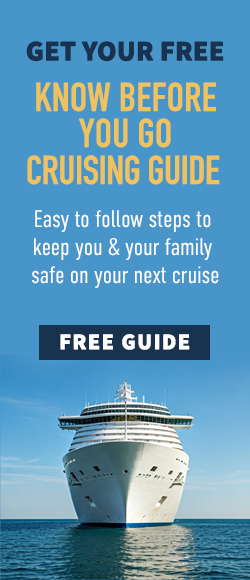Via: chicagotribune.com
By: Chabeli Herrera
After at least a dozen drownings or near drownings on cruise ship pools in the past several years, three major cruise lines now have lifeguards on duty.
Norwegian Cruise Line is the latest to add lifeguards, announcing recently that the line would roll out guards at family pools beginning this summer on its largest ships Norwegian Escape, Norwegian Getaway, Norwegian Breakaway and Norwegian Epic. The remainder of the Miami-based line’s fleet will have lifeguards by early 2018.
Norwegian will also begin offering complimentary swim vests for adults and children, which it hopes to offer across all its ships by this summer, said NCL spokeswoman Vanessa Picariello.
The line has stationed deck attendants who are certified in first response on its four mega ships since 2015, said Andy Stuart, president and CEO of NCL, in a statement, but will now add dedicated lifeguards.
“While parents are always the first line of supervision when it comes to water safety, we felt it was important to provide this added measure across our fleet,” Stuart said.
The announcement comes two months after Royal Caribbean International also decided to start posting lifeguards at every pool, including in the adults-only Solarium area. The change began in February with the Oasis of the Seas; all remaining ships in the line’s fleet will have lifeguards by June.
Miami-based Royal Caribbean is partnering with IAM StarGuard Elite, which will provide licensed lifeguards, consulting and risk-prevention services. The lifeguards, who will wear red-and-white uniforms, will not serve other roles on the ship, as often is the case with crew members who take on various tasks on cruise ships. The line also will offer a 15-minute water safety presentation during the embarkation-day open house session for Adventure Ocean, Royal Caribbean’s youth program.
Royal Caribbean began offering life jackets for children to use in the pool in late 2015.
Until the dual announcements this year, Disney Cruise Line had been the only line to offer lifeguards. The change was prompted by a March 2013 incident when a 4-year-old nearly drowned in a pool aboard the Disney Fantasy and suffered a brain injury, resulting in a multimillion-dollar settlement and lifeguards on all Disney ships.
The lack of lifeguards on cruise ships (which instead stress parental supervision), a practice that hotels also follow, has become an increasingly contentious issue after multiple drownings, most of them involving small children, on ships from the major cruise lines.
Last summer, an 8-year-old boy drowned on Royal Caribbean International’s Anthem of the Seas. The year before, a family sued the line, demanding that it add lifeguards at pools after a 4-year-old nearly drowned in a wave pool on Oasis of the Seas. In 2014, a 6-year-old boy suffered a brain injury after nearly drowning on Independence of the Seas.
The Aqua Park on the Norwegian Epic includes three water slides, two main pools, children’s Splash and Play Zone, and five whirlpools in a 2010 file image. After a spate of drownings, Norwegian Cruise Line is the latest to add lifeguards to its family pools beginning in the summer of 2017.
(Marjie Lambert / Miami Herald)
Three children aboard Norwegian Cruise Line ships have drowned or nearly drowned. In May 2015, a 10-year-old girl drowned on the Norwegian Gem and in February 2014, two children were found in a pool on the Norwegian Breakaway. A 4-year-old boy died, and his 6-year-old brother was airlifted to the hospital in critical condition.
In 2013, a 6-year-old boy from Orlando drowned aboard Doral-based Carnival Cruise Line’s Carnival Victory. That same year, a 41-year-old man drowned in a hot tub on the Carnival Dream.
Cruise lines are protected by a 1920 law, known as the Death on the High Seas Act, that exempts them from nearly all financial responsibility in the death of a non-wage earner, such as a child or retiree. The only financial burden on the lines would be funeral costs for the victims, which doesn’t incentivize cruise lines to post lifeguards, said maritime attorney Michael Winkleman, of Miami-based firm Lipcon, Margulies & Winkleman. The firm has litigated various cruise drowning or near-drowning cases.
But large settlements like the one in the Disney case, as well as growing public pressure to add lifeguards, finally forced the lines to change their policies, he said.
“Public sentiment shifted because of the sheer number of children that began drowning on cruises,” Winkleman said. “A lot of people said, ‘Where are the parents?’ I absolutely think parental responsibility plays a major role. But when it was up to a dozen children, those naysayers said, ‘Gosh, maybe these big corporations should take a simple step to keep our families safe.”
Carnival Cruise Line is now the only major cruise line without lifeguards, despite often touting that it’s the cruise line that “sails the most families,” including a large number of children.
Jennifer De La Cruz, a spokeswoman for the line, said Carnival has always taken pool safety “very seriously” and will continue to make “significant” investments to train employees on water safety, CPR and first aid. The line has two dedicated water safety management roles on its fleet to audit the line’s operations.
Carnival offers complimentary life vests, uses safety nets around its pools when they are closed and provides pool safety information to parents with children under 12 years of age. Still, the line has made no commitments to add lifeguards in the future.
“Carnival is the last hold out,” Winkleman said. “I think the pressure on Carnival is now going to be huge.”






